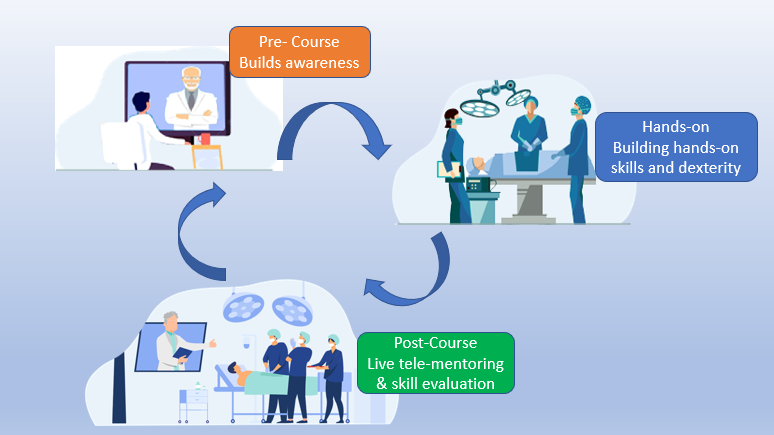India is a country with a population of nearly 1.3 billion people. India has a very low doctor-to-patient ratio and it becomes more abysmal when we consider the surgeon-to-patient ratio.
We also have to remember that India has a huge disparity in terms of standards of living, the kind of facilities available in metro, towns, rural areas. The population in a rural area can be considered lucky if they have a local surgeon in a 50-100 km radius. The problem is this surgeon is in most cases a general surgeon and hence getting treatment for specific issues that require Ortho, Neuro, ENT or even Dental surgeons becomes a challenge. This skewed ratio has put tremendous pressure on healthcare service delivery in our country. Patients in smaller towns and rural areas can expect to get treatment only for limited diseases as could be managed by the local surgeon. When a patient with an advanced disease diagnosis approaches the local surgeon (if one is available), he is advised to go to the nearest city to a tertiary care hospital. This is true not only for patients from small towns or rural areas but also in the cities and metros approaching a surgeon in a small nursing home. This results in the tertiary care hospitals overflowing with patients which in turn means very minimal time that can be given to each patient.
This problem is being solved to an extent through surgical conferences and workshops and also through some courses offered by surgery training institutes. The statutory requirement of collecting credit points through CME’s approved by the state or the national council does help in a limited way by ensuring some knowledge dissemination to the medical professionals. But one can’t overlook the fact that surgery is a matter of skill and dexterity and just watching some videos will not improve the surgical skills. The ability of the surgeon to wield all the surgical instruments with consummate ease, having fine control, being able to maneuver the anatomy and the tissue in question, even in the most challenging cases will decide the outcomes of a surgical procedure.
India is in dire need of a large number of skilled surgeons and hence it becomes imperative to have in place a system of education that is convenient, effective, safe, scalable and progressive. Let’s look at why these are the necessary and sufficient properties and how each of these would shape the outcome of a surgery training course.
Convenient:
A training course at any surgery training institute requires a physical presence of the surgeon for a minimum of 3-5 days. For outstation candidates, it means an additional cost of travel and stay. An even bigger cost is losing out on a week of clinical practice and surgeries. The last one is not just a financial impact for the surgeon but it also impacts all patients who are dependent on the only surgeon available to them locally. A training course that can be arranged within a 50 km radius would mean that the surgeon can operate in the mornings, travel to the training center for hands-on skills practice and get back to the hospital for the OPD/rounds by evening. If a skills center is not available at a quickly accessible location, then the learner should have an option to practice the skills locally at the hospital or any place for that matter. Surgery training courses will be accepted by the surgeons only if it takes into account the real problems of the surgeon.
To ensure improvement in surgical training courses, the theory can be disseminated through online mediums but it is imperative that we need to consider the availability of hands-on training centers in every district. Online training coupled with local skill centers will be the most convenient and inspiring opportunity that we can offer the surgeons.
Effective:
If a surgery training course does not guarantee a tangible change in the understanding and skill levels of the surgeon, it is a pure waste of time and money. Any course that is being conducted should be done with the objective of taking the surgeon to a higher level of knowledge and skill. The courses that last for less than a week just bombard and overwhelm the learner with information, offer very little chance to practice the hands-on exercises and result in a very small percentage of learners who have the confidence to handle cases using the newly taught concepts and techniques.
An effective surgery training course needs to have a structure and process that hand holds the surgeon till the time the surgeon reaches a higher level of skill. Confidence building in the learner can be achieved through regular mentoring and skill evaluation processes. With the use of technology this can be done remotely and at the convenience of the mentor and mentee.
Safe:
There are 2 critical factors for ensuring safe outcomes from a surgery – deep understanding of the surgical anatomy and dexterity in handling the surgical instruments while doing surgical steps such as dissection, knotting and suturing. Understanding of surgical anatomy can be done by watching surgery videos, assisting senior surgeons in surgery and through many other ways. However, surgical dexterity can be achieved only by continuous practice. The problem is a surgeon cannot afford to develop this skill by practicing on live patients. Training on cadavers has been an approved and safe way to practice. Nowadays, non-cadaveric surgical models are available that give the surgeon a real-life experience of surgery.
A surgical training course should have exercises that can be done on tissues, cadavers or models. If the faculty can guide the learner on developing some models on their own, it can help the learner practice the surgical skills at will in a safe way and that too at a fraction of the cost.
Scalable:
There are only a handful good surgery training institutes in our country today. An effective training course requires good faculty to give time to observe the learners, handhold them and mentor them when they practice their skills. In a surgery training institute, there is a limitation on the number of learners that can be accommodated and hence the faculty requirement is also limited. In some other cases, the institute limits the number of learners due to unavailability of good faculty.
To ensure a course that is scalable, we need to ensure that a substantial number of good faculty is available all the time and the delivery mechanism should also be able to accommodate a large number of simultaneous learners. This is possible only in a distance learning course as the faculty can deliver the course from anywhere. Given an option and resources, the institute can onboard faculty from anywhere in the world. Since the course is being delivered online and not restricted by space constraints, a large number of learners can be enrolled for the course.
Scalability is an important factor as it will take the country’s healthcare service to the next level in a short period.
Progressive:
As is the case with any other profession, there is a certain growth path that a surgeon can follow. Let’s take an example of laparoscopic surgery. A novice practitioner of laparoscopic surgery will typically attempt to do a couple of surgical procedures like laparoscopic cholecystectomy and laparoscopic appendicectomy. The most common next milestone is to start doing laparoscopic hernia repair and then move further into onco surgeries. Generally, a surgeon after a few years of practice with a certain set of procedures wishes to move to the next level of skill and for this, needs to undergo some formal training at a surgical training institute. Medicine and surgery has reached such fine levels of super specialization that a surgeon will need to invest a lot of time attending courses to achieve the next milestone of surgical skill.
Surgical courses delivered through the distance learning mechanism can speed up this process as the surgeon can move from one level to the next at his own convenience. Also, as seen earlier since the distance learning mode of surgical training is much more cost-effective for the surgeon, there is a better chance that the surgeon will adopt continuous learning as a way of life and keep improving his surgical skills in length (types of procedures) and breadth (skill level to do complicated cases in each type of procedure).

DISSECT – Distance Surgical Education and Capability Training is an online surgical education platform that addresses the 5 requirements mentioned earlier. It is essentially structured as a 3-phase course with a Pre-course phase that builds awareness in the learner, a hand-on phase that focuses on building hands-on skills and dexterity and the most important Post-course phase that gives confidence to the learner through continuous hand-holding, live tele-mentoring and objective skill evaluation that precisely identifies the shortcomings in the learner and helps in focused learning and improvement.
Learn more at- www.dissect.live



